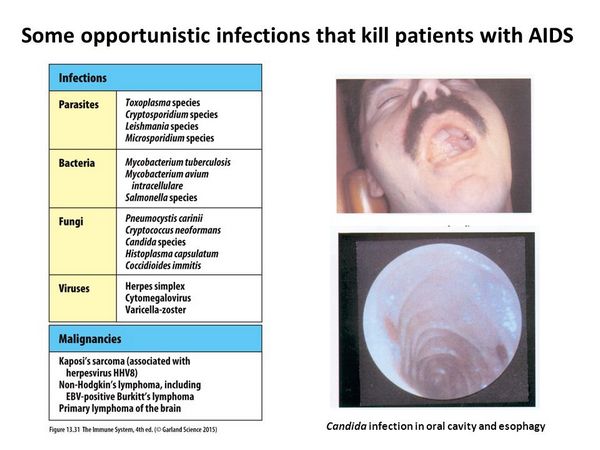Paeruginosa infections may occur in patients with AIDS. Risk factors for infection include a CD4 count of < 100 cells/mL3, neutropenia or functional neutrophil defects, intravascular catheterization, hospitalization, and prior use of antibiotics including ciprofloxacin or trimethoprim-sulfamethoxazole. Many cases are community acquired. Bacteremia is common, and the lung or an intravenous catheter is the most frequent portal of entry.
An impaired ability to mount immunotype-specific antibodies to Pseudomonas lipopolysaccharide antigen has been noted in HIV-positive individuals with bacteremia. Relapse is frequent, and mortality is high, 40%. Pneumonia is usually associated with cavitation and a high relapse rate. Bacterial sinusitis is an important and frequently undetected illness in HIV-positive individuals, and P aeruginosa is a frequent cause. Fluoroquinolone resistance may result from its use for the treatment of Mycobacterium avium complex.

Other infections caused by P aeruginosa described in patients with AIDS include malignant otitis externa, corneoscleritis, corneal ulceration and orbital cellulitis, meningitis, peritonitis, soft tissue infections, and osteomyelitis including osteitis pubis.
Diagnosis
The diagnosis of a P aeruginosa infection requires the identification of the clinical syndrome by history, physical examination, and laboratory testing. The specific syndrome influences the duration of antimicrobial therapy and the need for surgical intervention. In patients with positive blood cultures, it is critical to determine the source of bacteremia. Microbiological diagnosis requires the recovery of P aeruginosa from culture. Gram-negative bacilli in culture should be screened for the presence of oxidase. Oxidase production excludes most gram-negative bacilli other than Pseudomonas spp. Definitive diagnosis requires the use of specific microbiological tests to distinguish P aeruginosa from other Pseudomonas spp.
Treatment
Antimicrobial therapy of P aeruginosa infections is outlined in Box 54-2. Resistance of P aeruginosa in vitro to many antimicrobial agents is widespread and is increasing in frequency. Susceptibility testing should be performed on all clinically significant isolates to guide the selection of appropriate antimicrobial therapy. In addition, the following principles should be considered:
- Antibiotics active in vitro against P aeruginosa often include extended spectrum penicillins with or without the combination of a ß-lactamase inhibitor; some third-generation cephalosporins (ceftazidime, cefoperazone); fourth-generation cephalosporins (cefepime); carbapenems (imipenem, meropenem); monobactam (aztreonam); aminoglycosides (gentamicin, tobramycin, amikacin, netilmicin); and fluoroquinolones (for example ciprofloxacin).
- In general, therapy with a ß-lactam antibiotic should not be used as monotherapy. In severe infections a ß-lactam should be combined with an aminoglycoside or a fluoroquinolone. Successfully used in the treatment of other gram-negative infections, once-daily dosing of aminoglycosides can be considered in P aeruginosa infections.
- A fluoroquinolone is the only effective antimicrobial that may be administered orally.
- Patients with a history of major ß-lactam allergy may be treated with a fluoroquinolone, aztreonam, or, cautiously, a carbapenem often combined with an aminoglycoside in severe infections.
- Optimal therapy often requires surgical intervention. Examples include left-sided endocarditis, PVE, necrotizing enterocolitis, malignant otitis externa, osteomyelitis, and prosthetic joint infection.
- Modifications of antimicrobial therapy may be necessary when antimicrobial susceptibility data are available.
CF patients represent a particular challenge to therapy. Altered pharmokinetics frequently necessitate higher doses of antimicrobial agents than in other patients. Colonization with resistant strains is common in patients with CF. The administration of intermittent antimicrobial therapy to CF patients with chronic pseudomonal infections and the use of nebulized antimicrobial agents may reduce the frequency of Pseudomonas infection in CF patients. Despite theoretical concerns about fluoroquinolone incorporation into developing cartilage in pediatric patients, ciprofloxacin has been used successfully and safely in these patients.
Antimicrobial resistance is increasing worldwide among strains of P aeruginosa. ß-Lactam resistance may be due to mutational derepression of the ampC chromosomal ß-lactamase, the acquisition of plasmid- or transposon-mediated ß-lactamases, reduced permeability of P aeruginosa to antimicrobial agents, multidrug efflux pump systems, and, in the case of carbapenems, loss of the D2 porin. Zinc-containing ß-lactamases confer resistance to carbapenems.
Many strains produce inducible cephalosporinases that account for the rapid emergence of resistance during therapy. Aminoglycoside resistance may be caused by decreased uptake owing to overproduction of the major outer membrane protein H1, aminoglycoside modifying enzymes, or modification of ribosomal targets. Mutations in the gyrA gene may cause resistance to ciprofloxacin and other fluoroquinolones.
Prevention & Control
P aeruginosa is primarily a nosocomial pathogen, and control measures should be focused on hospital infection control. Appropriate sterilization of all equipment and prompt recognition of hospital outbreaks are essential. Hand washing after patient examination and additional measures such as wound and contact isolation for multiply resistant P aeruginosa should be performed. In particular, measures to decrease the spread of P aeruginosa between patients at CF clinics are necessary.




